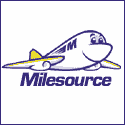
Tuesday
April 26, 2:05 PM ET
Airbus A380 Set for Maiden Flight Before 50,000
By
LAURENCE FROST, AP Business Writer
BLAGNAC,
France - After
11 years of preparation and $13 billion in spending, the world's
largest passenger plane, the Airbus A380, is scheduled to fly for the
first time on Wednesday.
Weather
permitting, Airbus test pilots will
power the four engines on a test model of the 555-seat "superjumbo" to
lift its 308-ton frame aloft. About 50,000 onlookers are expected for
what some are calling the biggest aviation event since Concorde's first
flight in 1969.
The
first A380 flight is tentatively set to
begin around midmorning and could last for much of the day as the plane
circles the region, beaming back real-time measurements of 150,000
parameters to Airbus headquarters from its 20 metric tons (22 tons) of
on-board test instruments.
Industry
analysts are keeping a close watch
on Airbus, which hopes to woo customers away from rival Boeing Co. with
the A380 but has yet to prove that it can turn a profit on its
superjumbo investment, a third of which came from came from European
governments.
As
Airbus and Boeing spar over what each
calls unfair government subsidies for the other, the rival aircraft
manufacturers have staked their success on competing visions of the
future of commercial air travel.
The
A380, with a catalogue price of $282
million, represents a huge bet that international airlines will need
bigger aircraft to transport passengers between ever-busier hub
airports. But some analysts say signs of a boom in the market for
smaller wide-body planes, such as Boeing's long-range 787 "Dreamliner,"
show that Airbus was wrong to focus so much time and money on its
superjumbo.
Just
this week, Air Canada said it had firm
orders for 32 new Boeing jets, including 14 787s, with a list value of
about $6 billion, and Air India announced plans to order 50 Boeing jets
worth $6.8 billion. Air India wants 27 of the 787s, which will carry up
to 257 passengers and have a list price of $120 million, boosting total
orders and commitments for the plane to 237. The 787, which was
launched a year ago, is scheduled to enter service in 2008.
"If
the A380 costs Airbus the mid-market
then it's the biggest misinvestment in aerospace history since
Concorde," said Richard Aboulafia of the U.S. consultancy Teal Group.
"The way the market's changing makes this look more like a science fair
project every day."
Airbus,
a unit of European Aeronautic
Defence and Space Co., is also planning to bring its own mid-sized
jetliner, the A350, into service in 2010 — two years after
the Boeing 787, but the United States government is demanding that no
European government launch aid be extended for the A350.
So
far, Airbus has booked 154 orders for
the A380, which it says will carry passengers 5 percent farther than
Boeing's longest-range 747 jumbo at a per-passenger cost up to
one-fifth below its rival's.
While
plane enthusiasts have lined fences
in recent days at the airport in the Toulouse suburb of Blagnac, where
Airbus is headquartered, Airbus has warned that the first flight of the
A380 — already about a month behind schedule —
could be further delayed by any unforeseen weather conditions.
A
strong southerly wind from the
Mediterranean would mean automatic postponement, since it would require
a takeoff over the town — considered too risky for a test
flight.
Aviation
experts say risks remain very slim
on the maiden test flight since a plane's aerodynamic characteristics
are already well known before it takes off, thanks to years of computer
modeling and wind-tunnel tests.
Problems
are more likely, but still very
rare, later in the test-flight program, when the pilots deliberately
take the plane to its limits. An Airbus A330 prototype crashed here in
July 1994, killing chief test pilot Nick Warner and six others as they
conducted a simulated engine failure exercise.
Airbus
chief test pilot Jacques Rosay,
flight captain Claude Lelaie and four fellow crew members will take no
chances. They will wear parachutes during the first flight, in
accordance with Airbus policy. A handrail leads from the cockpit to an
escape door that can be jettisoned if the pilots lose control of the
plane.
The
test-flight program is likely to finish
soon before the A380 enters service for Singapore Airlines in mid-2006,
Airbus said — about three months behind the previous
schedule.
Part
of the delay is down to the superjumbo's struggle with a weight problem
that consumed months of engineering time and most of the program's
$1.88 billion in cost overruns. Competitive pressure on airlines to
offer plusher business-class seating tightened the squeeze —
compounded by the A380's sheer scale.
Whichever
way the wind blows in Toulouse on Tuesday, the A380 seems certain to
become a milestone in civil aviation history alongside the 747 and
Concorde. Unlike the supersonic Concorde, however, whose claim to fame
was how fast it crossed the Atlantic, this latest fruit of European
aerospace cooperation will ultimately be judged on how fast it makes
money.
The
Associated Press contributed to this report.
Copyright
© 2005
The Associated Press. All rights reserved. The
information contained in the AP News report may not be published,
broadcast, rewritten or redistributed without the prior written
authority of The Associated Press.
AviationHistory.org shall not be liable for any errors or delays in the
content, or for any actions taken in reliance thereon.
|













